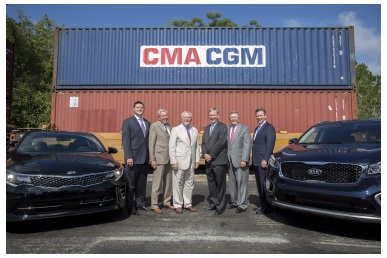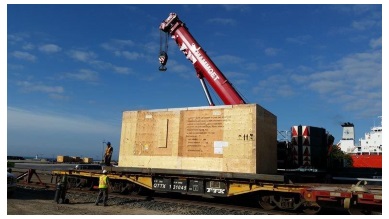Intermodal: Georgia, Oshawa
Georgia: Inland Port Rail Partnership to Handle Containerized Kia Parts Imported via Savannah

Georgia Gov. Nathan Deal announced August 3 that Kia Motors Manufacturing Georgia has partnered with Cordele Intermodal Services (CIS) to move cargo by rail from the Port of Savannah to the CIS container yard in Cordele. Above, Gov. Deal, center left, is joined by CIS President Jonathan Lafevers, Georgia Rep. Buddy Harden, KMMG Chief Administrative Officer Stuart C. Countess, Georgia Ports Authority Board Chairman Jimmy Allgood and GPA Executive Director Griff Lynch at the rail yard, with finished vehicles on display.
Photo/Stephen B. Morton, Georgia Ports Authority
Cordele Intermodal Services (CIS), Georgia's first inland terminal, will partner with Kia Motors Manufacturing Georgia (KMMG) to handle up to 30,000 TEU containers per year to supply the Kia manufacturing plant in West Point.
With this new partnership, KMMG will move auto parts via rail from the Port of Savannah to Cordele and then by motor carrier to West Point.
Previously, the automaker would have trucked containers from Savannah to West Point. This agreement allows trucks carrying Kia parts to make much shorter hauls between Cordele and West Point.
The Georgia Ports Authority (GPA) says the arrangement with CIS will save KIA Motors transit costs and cut more than 6.0 million truck miles from state highways each year.
"Cargo can be loaded onto trains, moving hundreds of containers in a single trip, staged at an intermodal yard, then trucked for much shorter distances," said GPA Executive Director Griff Lynch. "This model drives out waste and redundancy in the supply chain, delivering greater efficiency for customers and environmental benefits through reduced diesel consumption."
KMMG’s West Point facility employs more than 3,000 workers and can produce up to 360,000 vehicles annually. Together with local suppliers, Kia has created more than 15,000 jobs in the area.
"Working with our state partners, as well as our suppliers, in this way not only benefits KMMG, but also increases efficiency, which adds value to the end product, ultimately benefiting our customers," said Stuart C. Countess, chief administrative officer of KMMG. "We see this as another example of our company philosophy of continuous improvement."
"There is a direct cost savings to the importer," said CIS President Jonathan Lafevers. "Furthermore, storage and handling fees are reduced or completely eliminated by utilizing Cordele as the origin and destination location for the containers."
Cordele Inland Terminal, served by short line rail providers, currently operates on 40 acres with an option to expand on additional available land nearby. Service areas include southwest Georgia, southern Alabama and western Florida. Ocean carriers Maersk, NYK, CMA-CGM, MSC and ZIM recently designated Cordele an official container yard.
On July 22, the GPA board approved $19.7 million to fund the state's second inland terminal — the Appalachian Regional Port in Murray County.
Port of Oshawa Rail Spur Pulls Its Weight

100-ton compressor on railway flatcar at Port of Oshawa prior to loading on to a ship for export to South Africa
Photo/Oshawa Port Authority
A new rail spur has given the Port of Oshawa competitive access to the project cargo market, opening the door to cargo of all shapes and sizes, including a mammoth motor compressor shipped to the port by a company in the Central Ontario city of Kawartha Lakes.
The rail spur’s oversized dimensional section easily accommodates the 100-metric-ton compressor, which was too large to be transported over the road. After arrival at the port, the transformer was hoisted aboard the heavy lift vessel MV Marsgracht for export to South Africa.
"It’s great to see that industry recognizes the distinct advantages of Oshawa’s intermodal port," said Donna Taylor, president and CEO of the Oshawa Port Authority. "This is the first project cargo to be exported using the rail spur, and we’re confident that it’s just the start."
The spur, which opened in May 2015, has also helped Oshawa compete for steel cargo. So far this year, 87 steel-laden rail cars have arrived here from western Canada.
"The rail spur is the crucial link that allows us to meet the growing demands of local and regional businesses," said Port Authority Chair Gary Valcour. "It’s the kind of investment that helps the port deliver significant economic benefits for Oshawa, Durham Region and all of Canada."
The port authority totally funded the $4.1 million rail spur with no outside government assistance.

